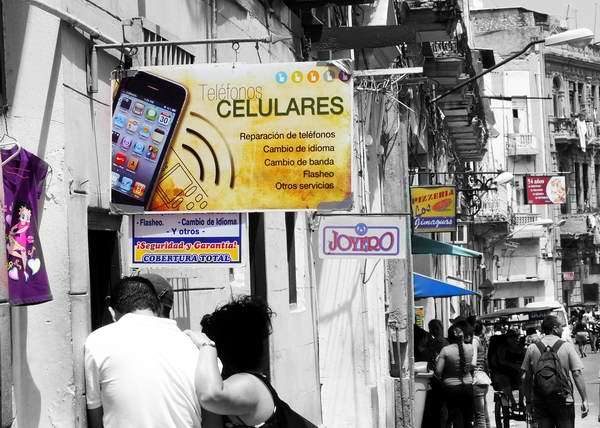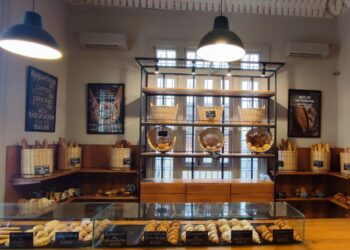In Santiago de Cuba there is a central beauty parlor by the name of Vogue, which refers to a famous fashion magazine, at the Callejon del Carmen, in front of a bronze sculpture of composer Miguel Matamoros.
There is not a sign identifying the place. Its walls are barely naked and the prices of the services offered can be read in a rustic list. The ironing is the most expensive service, it can cost up to 50 Cuban pesos (CUP) for long hair. All services are charged in CUP. The services offered seem to be the same; however, a lot has changed.
These kinds of businesses were previously owned by the State; today their facilities are lent by the State to the self-employment sector. At present, Vogue is run by eleven hairdressers and two manicurists.
The current tenants have to pay taxes for the facilities and for performing their job (a permit), as well as for water, electricity, necessary products, social security and they have to leave room for an investment fund. It seems overwhelming…
Nonetheless, Mirurgia, a fit Cuban woman with more than ten years of experience in hairdressing, expressed her opinion while taking care of a client:
“It is true we have to become economists, to learn to save money and resources, invest, and be able to support our families: it is not easy, but we have to learn, this is our business now, we own it”. There are no bosses and you can adjust your schedule and take care of clients. We used to earn 250 CUP and now earnings are up to us. Besides, we put an end to certain disadvantages because no one steals from oneself”.
Odalys, another of the workers at Vogue, talked about the prices of the product they need to buy in Cuban convertible pesos (CUC) at the stores and in some cases in their equivalent in CUP (25.00 CUP per 1.00 CUC). She raises her eyes and opens up her hands while referring to the prices of a bottle of shampoo or a cream pot, which cost about four or five CUC: we are tied up so we cannot lower prices for the services offered to the population, she explains.
The lack of wholesale trade for the self-employment sector is an urgent need in order to face the current economic diversification Cuba is going through. That’s an unfinished issue.
Time … and dinning tables
We move from the sphere of beauty to depression. The Electronic Watchmaking Workshop is located in one of the main streets of the city: Enramadas. It is a few meters away from a singular park: some years earlier its shop windows used to display pictures of outstanding workers, now the place is surrounded by big tents, tables and beer.
We walked in: there are several tables with the characteristic light at the top, lenses and tiny pliers. A change of battery or a crown, maintenance. The service is unequivocal.
Vicente’s hair has become gray in this job. One of his regular customers extolls his experience and nice treatment, and notes that when he can’t afford one of the services Vicente offers, there is always a solution or a different means of payment, which would have never been possible before.
Vicente pays a total of 83 CUP for the place, 50 for the permit and, in his particular case, 87 for social security. They may be self-employed but their right to a retirement pension is guaranteed, though the amount depends on their contribution.
“We have been renting here for three years and I keep my place. The main difference now is that our hands were tied because our enterprise had a lot of difficulties in providing us with pieces and parts, if we managed to get it somewhere else… we were sanctioned. Now we are in charge of all that. I remember once we had some problems with the roof and the maintenance team did nothing about it so we fixed with our own resources”.
Leaving aside watchmakers we moved to the Agricultural Market La Plaza. It is a historic place and it is huge. It is located two blocks after Cespedes Park and a few clocks from the harbor. Colors and odors tell us about it.
These workers are not referred to as self-employed by as frequent sellers; though they also rent sales points which vary from 10 CUP for selling spices; 30 for grassroots vegetables, fruits and vegetables; and 50 for meat. Some of these workers have been here for years; some of them date back to the inauguration of the market in 1994, under the principle of offer and demand, with no participation of the State.
The general manager showed us the document stating the name of the sellers, their ID, the products they sell and its prices. Everything seems to be in order in paper. Most of the products offered are supplied by trucks coming from close provinces like Guantanamo and Holguin. Everything is shining in terms of order and hygiene. It is already past 10 a.m. and I haven’t seen any inspector, yet everyone affirms they will be there soon.
I accompany Xiomara, a retired professor. She finally decides to buy some lemons, they cost four CUP a little jar, one pound of tomatoes is seven and one pound malanga is five. She walks by kidney beans which cost 15 CUP per pound. When I point at her to the meat stand she frowns and makes reference to her modest retirement pension of about 200 CUP.
I invite you to read the list of prices with me: Smoked leg 35 CUP / Ham 32 CUP / Sausage 30 CUP / Bacon 30 CUP / Chopped sausage meat: 25 CUP.
All these products are derived from pork meat. According to Maykel, the seller, products arrive from a cooperative. He is a strong 34-year-old young man, who recently had a child, and wears a white robe and a thick golden chain on the neck. Some time ago he took part in Mision Milagro (Venezuela) in the custody of medical equipment. He used to earn 320 CUP monthly out of that job in a warehouse, now he doubles that figure in a week work.
Self-employment is gradually gaining space, as well as economic and mental readjustment. Society is facing a complex reality, with still a lot to learn, but also with men and women with a lot to give.










